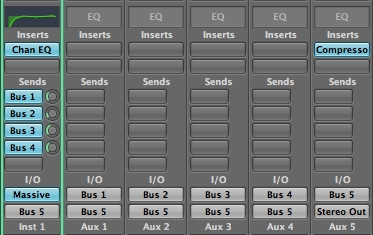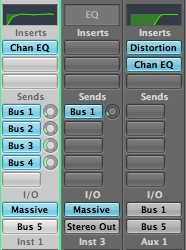
Do you ever wonder how your favourite producers create a sound that is so rich, full and detailed? Have you ever fired up your favourite synth and recorded in a banging synth line in a frenzy of excitement, only to discover the next morning that it sounds weak and weightless?
It's a head scratcher, that's for sure! That is, unless you know what the secret to a full and powerful mix is; well, that's what I'm here for! In this article I'm going to delve into one gloriously simple but effective technique utilising this key production ingredient - bus layering.
I've covered the basics of synth layering in another tutorial so I'll keep my description of it here brief. The idea essentially involves creating copies of either an audio part or MIDI pattern and using processing (in the case of audio layering) or different synth sounds (in the case of MIDI layering) to create a thicker, richer sound than either a single piece of audio or soft synth track on its own.

EQing and filtering should be applied to the layers to make sure they don't clash across the frequency spectrum - forgoing this step would cause undesirable (in most cases anyway) 'lumps' or peaks in the combined frequency spectrum of your layered sound.

Whilst the above process is relatively straightforward and can greatly improve your sound, it is quite pain-staking and can take a lot of time to get just right. The technique I want to discuss now leapfrogs a lot of the groundwork required with the traditional layering process, making it both speedy and highly effective.
The technique in question is bus layering, which, in a nutshell, simply involves sending the signal from your main part to a number of different bus channels that you can then process and transform to thicken up your sound.
Hop On The Bus
The aim is to transform the original sound into something different and yet inherently connected to this root part. You can get as creative as you like with regard to the processing applied on the bus channels - in fact, the whackier the better.
You should always bear in mind that the bus channel's sound is going to be mixed with the original, so the more different it sounds, the more of a difference it will make to the combined sum of both parts.
Before you begin however, remember this - because you are multiplying the amplitude of the original track by all your bus parts, you'll either need to reduce the volume of the original sound or bus out the original part and all the buses to a master bus, then apply a compressor and/or limiter to keep the combined volume in check.

To give you a tried and tested effect chain to get your experimentations started, load up a distortion plugin followed by a multi-band EQ on your first bus channel. Crank up the distortion and roll off the lower frequencies with your EQ - pull the send volume to your distortion bus all the way back to nothing, play your original sound and slowly bring up the send amount to your bus.
Notice how the sound begins to brighten, as well as introducing a light, crunchy texture' You can then easily strengthen or weaken this effect by altering the amount of signal you send to the bus track.

Different Approaches
One approach to this technique is simply to try out any and all effects chains that come to mind and see how they sound in the mix. Another is to listen to your original sound in isolation on repeat a few times and to try to think about what it is lacking - does it need some movement?
Try a phaser/flanger/chorus on oner of your bus channels and really push up the modulation to create some internal movement. Does it need some weight' Use a high-pass filter and push up the bass frequencies with an EQ on your first bus.
The beauty of this technique is that in order to properly mix and balance your processed bus layers, all you need to do is return to your original track and alter how much signal you send out to each layer. You also get an immediate overview of how your combined sound is balanced at a glance, making it effortlessly easy to tweak to achieve mixing perfection.

One final trick you can use with bus layering is to send signal from multiple parts to your bus layer - this can really help to gel related parts together or create strange, complex layers in your music that are intimately connected to other parts of your arrangement. For example, say you have a melody and countermelody in a track.
You're sending the melody to a chorus unit on a bus track to thicken up the sound - try sending some of the countermelody to this bus channel as well in order to create more of a musical connection between the two parts.

I hope you've enjoyed my elucidation of the bus processing technique and are desperate to go and try out some of my tips and tricks in your music productions - experimentation and careful mixing are key but above all else, get inspired and be creative!
Get your layering experiments underway and pick up any of our loop and MIDI collections here.










